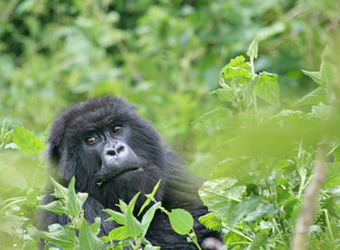Volcanoes Nat'l Park
| Read Reviews | Write a Review Start Planning Your Custom Safari
 view larger image
view larger image
Track gorillas in the early morning on the forested slopes of the ancient Virunga volcano chain in Africa’s oldest national park. Established in 1925 to protect the mountain gorilla, the park was the base for famous American naturalist Dian Fossey’s research. On the western edge of Rwanda bordering parks in both Uganda and the Democratic Republic of the Congo, the combined region is home to approximately 604 mountain gorillas, just over half the world’s total.
 view image gallery
view image gallery
The Safari Experience
This is one of the only places in the world where the critically endangered mountain gorilla can be seen – none are held in captivity anywhere in the world. The experience focuses strongly on gorilla trekking. Treks are done in the early morning in small groups of eight guests accompanied by local park rangers and porters to carry daypacks and camera equipment. While guests are grouped by physical ability, it is sometimes quite mixed, and we go at a pace to accommodate everyone. The rangers locate the gorilla families so that they’re relatively easy to find, however there is no guarantee on how long it may take, as they move quickly and cover large areas. Trekking can be moderately to highly strenuous uphill over sometimes muddy terrain. Once we reach the gorillas, we have one hour. No flash photography is allowed, and the minimum age for trekking is 15 years.
 view image gallery
view image gallery
Wildlife
The mountain gorilla is one of two sub-species of eastern gorilla, and the most critically endangered with a total population of about 1,004 living between Rwanda, Uganda and the Democratic Republic of Congo. These very social creatures are typically found in groups averaging 10 individuals, ranging from five to 30 individuals in any one family. Currently there are 10 gorilla families in Volcanoes National Park. They are always headed by a dominant silverback and include several females, other subordinate males and usually some youngsters. While large and strong, gorillas are typically docile and shy, and the young ones tend to be very playful. The silverback is not protective of territory, but rather protects the group itself and guides its movements to different areas on the mountain. Gorillas practice a midday rest period, much like our “siesta,” using this time to strengthen bonds, groom, and play.
 view image gallery
view image gallery
How to Include Volcanoes in Your Safari Itinerary
Recommended Number of Nights
Nature Travelers: 2 nights
Photographers: 2 nights
Families: 2 nights
Active Travelers: 2-4 nights
Other Regions to Include
It’s recommended to do two gorilla treks, staying in the park vicinity for 2-3 nights. An extra day or two here allows active travelers to climb Mt. Bisoke or Mt. Karisimbi, both inactive volcanoes. An overnight in Kigali, which is a beautiful three-hour drive from Volcanoes National Park, is recommended, and often necessary, either before or after gorilla trekking. Kigali offers a moving visit to the Genocide Memorial Centre or a cultural experience interacting with local communities. Rwanda is a natural extension before or after any east Africa safari in Uganda, Kenya or Tanzania. For those interested specifically in primates, Uganda’s Kibale Forest houses chimpanzees, Ugandan red colobus monkeys, the rare L'Hoest’s monkey and 10 other primate species. Uganda’s Queen Elizabeth National Park and Tanzania’s Mahale Mountains National Park also feature chimpanzees.
